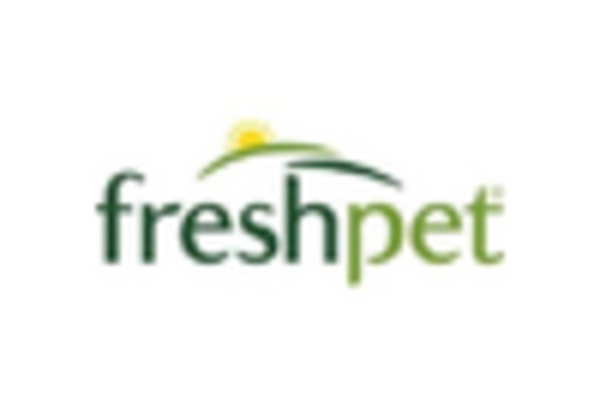The Direct To Customer Pet Food Market is currently characterized by a dynamic competitive landscape, driven by evolving consumer preferences and a growing emphasis on convenience and quality. Major players such as Nestle Purina PetCare (US), Mars Petcare (US), and Freshpet (US) are strategically positioning themselves through innovation and digital transformation. Nestle Purina PetCare (US) focuses on enhancing its product offerings with premium ingredients, while Mars Petcare (US) emphasizes sustainability in its supply chain. Freshpet (US) is leveraging its fresh, refrigerated pet food products to capture health-conscious consumers, collectively shaping a competitive environment that prioritizes quality and consumer engagement.
Key business tactics within this market include localizing manufacturing and optimizing supply chains to enhance efficiency and responsiveness. The competitive structure appears moderately fragmented, with several key players exerting influence over market dynamics. This fragmentation allows for niche brands to emerge, catering to specific consumer demands, while larger companies consolidate their market positions through strategic initiatives.
In August 2025, Mars Petcare (US) announced a partnership with a leading technology firm to integrate AI-driven analytics into its supply chain management. This strategic move is likely to enhance operational efficiency and improve product delivery timelines, thereby strengthening Mars Petcare's competitive edge in the market. The integration of AI not only streamlines operations but also allows for better inventory management, which is crucial in the fast-paced pet food sector.
In September 2025, Freshpet (US) launched a new line of plant-based pet food products aimed at environmentally conscious consumers. This initiative reflects a growing trend towards sustainability and aligns with consumer preferences for healthier, eco-friendly options. By diversifying its product range, Freshpet (US) positions itself as a leader in the sustainable pet food segment, potentially attracting a broader customer base.
In October 2025, The Farmer's Dog (US) expanded its subscription service to include personalized meal plans based on individual pet health assessments. This strategic enhancement not only caters to the increasing demand for tailored pet nutrition but also reinforces customer loyalty through personalized service. Such innovations are indicative of a broader trend towards customization in the pet food market, where consumer engagement is paramount.
As of October 2025, current competitive trends in the Direct To Customer Pet Food Market are heavily influenced by digitalization, sustainability, and the integration of advanced technologies. Strategic alliances are increasingly shaping the landscape, enabling companies to leverage shared resources and expertise. Looking ahead, competitive differentiation is expected to evolve, with a notable shift from price-based competition towards innovation, technology adoption, and supply chain reliability. This transition underscores the importance of agility and responsiveness in meeting the diverse needs of pet owners.


















Leave a Comment